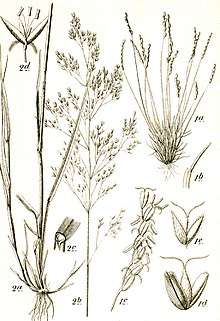Mibora
Mibora, or sandgrass,[3] is a genus of European and North African plants in the grass family.[4][5]
| Mibora | |
|---|---|
 | |
| Mibora minima (figure #1 a-d at right)[1] | |
| Scientific classification | |
| Kingdom: | Plantae |
| Clade: | Tracheophytes |
| Clade: | Angiosperms |
| Clade: | Monocots |
| Clade: | Commelinids |
| Order: | Poales |
| Family: | Poaceae |
| Subfamily: | Pooideae |
| Subtribe: | Sesleriinae |
| Genus: | Mibora Adans. |
| Species | |
| |
| Synonyms[2] | |
| |
Description
Mibora is a genus of very small to small annual grasses with erect or sometimes quickly ascending stems (often called culms) between 2 and 13 cm long, growing in tufts. As in all grasses the leaves consist at its base of a sheath closely enveloping the culm, a free standing blade at its tip and a ligule at the inside/upside where sheath and blade meet. The sheaths are tender, shallowly grooved rounded at their back, 0.2–1 mm long. The ligule is membranaceus and lacks fine hairs (or cilia). The blade is flat, folded along the midline or enrolled and 1–6 cm long which are up to 0.5 to 0.7 mm wide and have a stump tip. The spikelets consist of one fertile floret, which has 3 anthers.[6]
Key to the species
| 1 | Inflorescence embraced at base by a subtending leaf. Leaf blades folded along the midline or enrolled. Glumes similar in texture to the fertile lemma. Lemma ovate. Morocco. → Mibora maroccana |
|---|---|
| - | Inflorescence without a leaf at its base. Leaf blades flat or enrolled. Glumes more firm than the fertile lemma. Lemma obtuse. Spain, Portugal, France, Belgium, The Netherlands, middle and southern England, Wales, and very rare in the eastern Mediterranean.[7][8][9] Introduced in the eastern USA and Canada, but does not maintain itself. → Mibora minima |
References
- 1795 illustration by Johann Georg Sturm - Figure 14 from Deutschlands Flora in Abbildungen
- Kew World Checklist of Selected Plant Families
- "Mibora". Natural Resources Conservation Service PLANTS Database. USDA. Retrieved 9 July 2015.
- Adanson, Michel. 1763. Familles des Plantes 2: 495 in French
- Grassbase - The World Online Grass Flora
- Editorial Committee of the Flora of North America (1993). Flora of North America: Magnoliophyta: Commelinidae (in part): Poaceae, part 1. Oxford University Press.
- The Plant List search for Mibora
- Cabi, E. & M. Doğan. 2012. Poaceae. 690–756. In A. Güner, S. Aslan, T. Ekim, M. Vural & M. T. Babaç (eds.) Türkiye Bitkileri Listesi. Nezahat Gökyiğit Botanik Bahçesi ve Flora Araştırmaları Derneği Yayını, Istanbul
- Altervista Flora Italiana, Cappellini minori, Early Sand Grass, Zwerggras, Mibora minima